Welcome: The Foggy Bottom Historic District
Introduction
Text-to-speech Audio
The walk leads you through the alleys, streets, and parks of the four-block working class Foggy Bottom Historic District. In the 1800s, and especially after the Civil War, industries developed in Foggy Bottom along the Potomac River. The Christian Heurich brewery, the Washington Gas Light works and other industry's smoky odors – added to the fog present in low lying areas – contributed to the name “Foggy Bottom.” In the 1880s, row houses (including alley houses) were built for working class Irish and German laborers. The area also saw an influx of African Americans during and after the Civil War, until by 1920, most residents of the Historic District were African American. By the 1950s, the industries closed down, the air cleared, and Foggy Bottom became a more desirable place to live. Row houses were renovated and new apartments were built.
This walking tour highlights the historic period, but Foggy Bottom's history did not end in 1915. The tour therefore also discusses more modern buildings and developments. Despite changes over time, the neighborhood remains a community that has worked to preserve its history, character, and quality of life.
This walking tour is part of the Foggy Bottom Association's History Project, which collects and shares the rich history of the neighborhood. To learn more about Foggy Bottom History, see the links below.
Images
Foggy Bottom History District Map (houses contributing to the Historic District in purple)
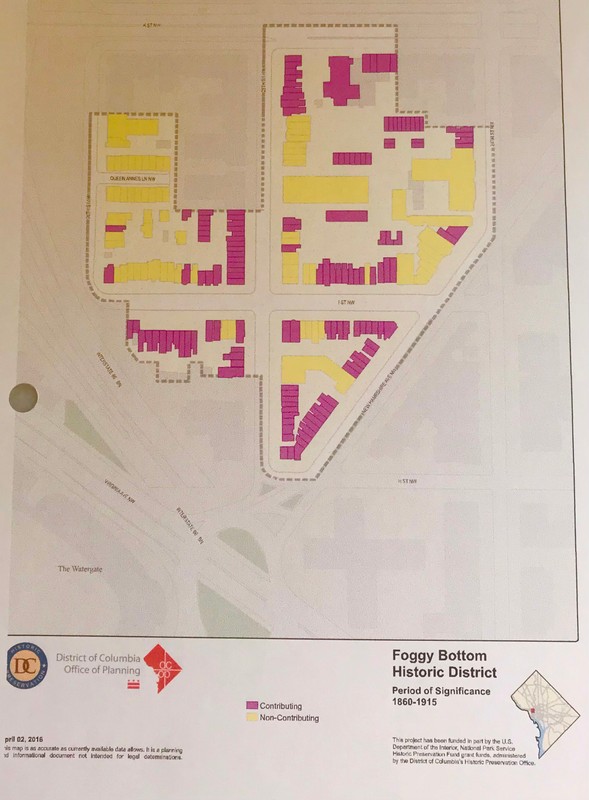
Entrance to the Historic District (NH Ave. and I St.)
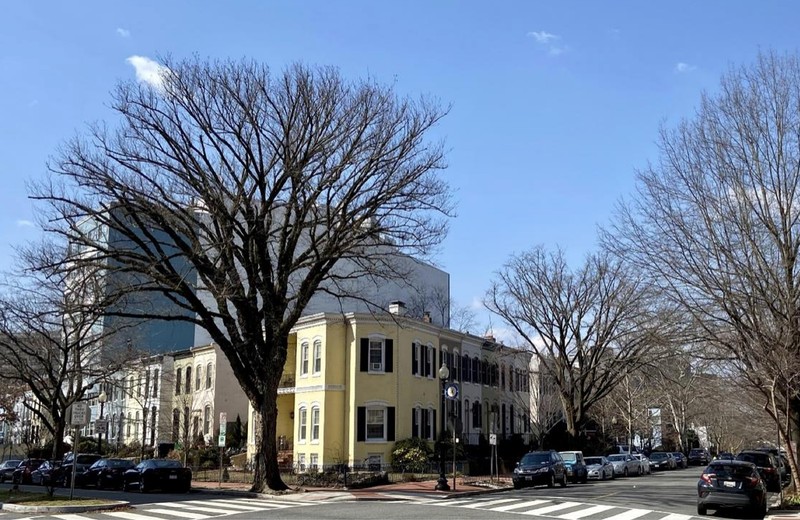
Kitty Snows in the passage way to Snows Court - she is a semi-feral "blue collar cat" tasked with rodent control in the alley
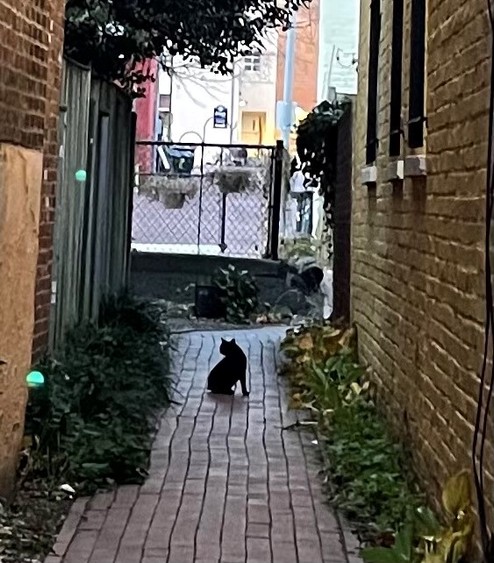
A continuous row of 1880s alley houses in Snows Court
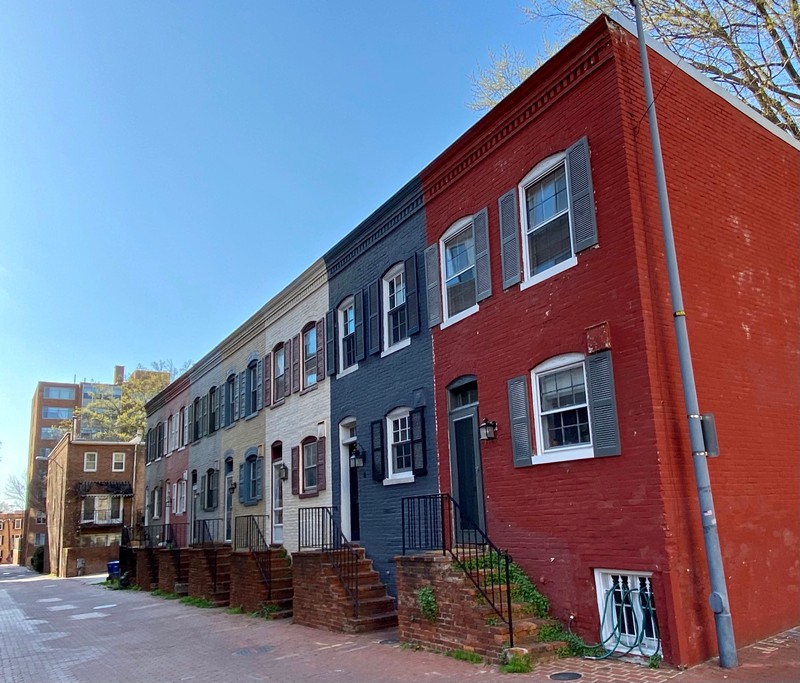
Various patterns of brick laying embellish row houses with molding above windows and doors and decorated cornices (900 block of 25 St.)
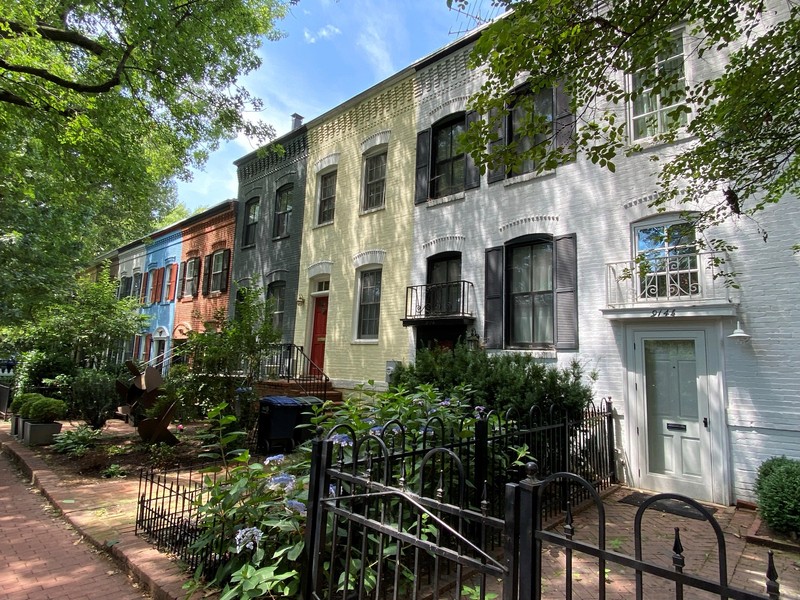
Trees and tree box gardens enhance the neighborhood's Row Houses (2400 block of I St.)
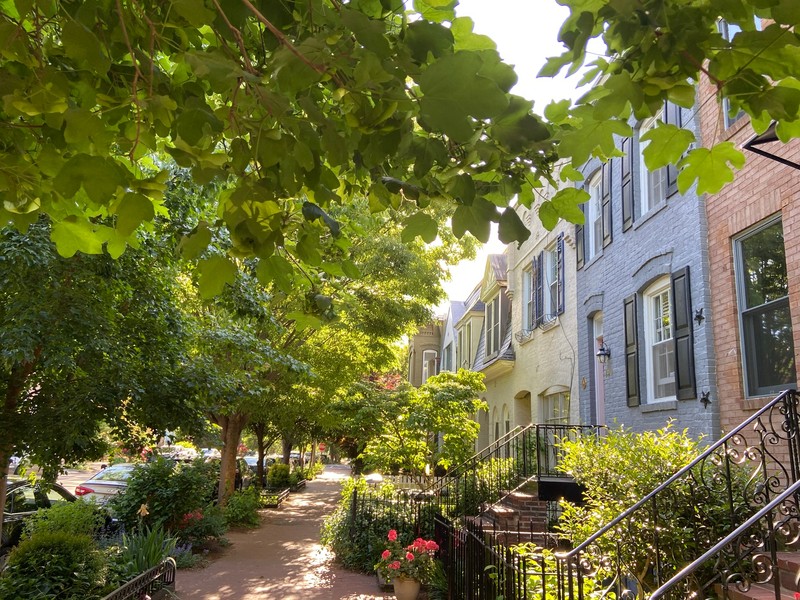
Neighbors gathered at a Foggy Bottom Street Fair (I St.), 1981
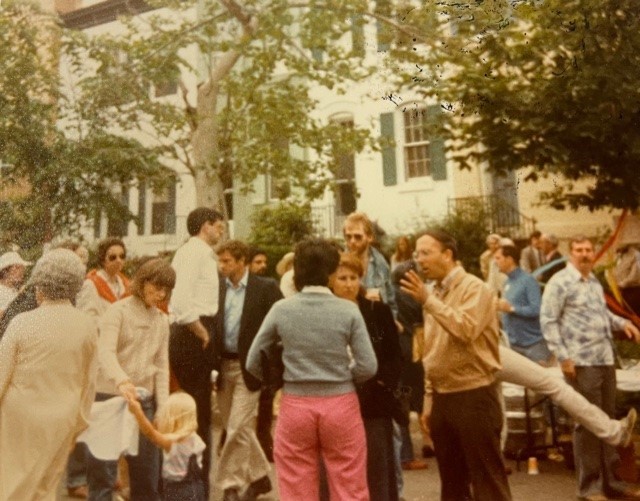
Queen Anne's Lane, leading to the western boundary of the Historic District
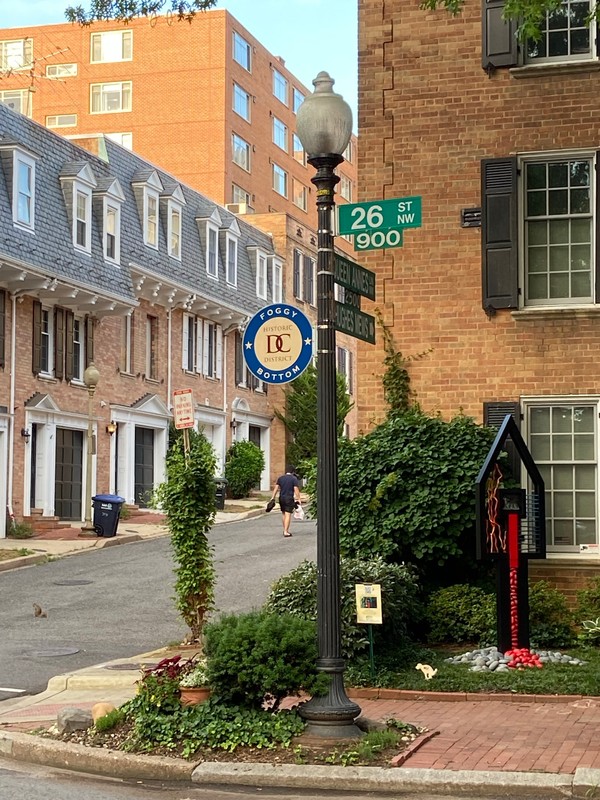
Distinctive houses at the bottom of the Historic District (25th and H Sts. and NH Ave.)
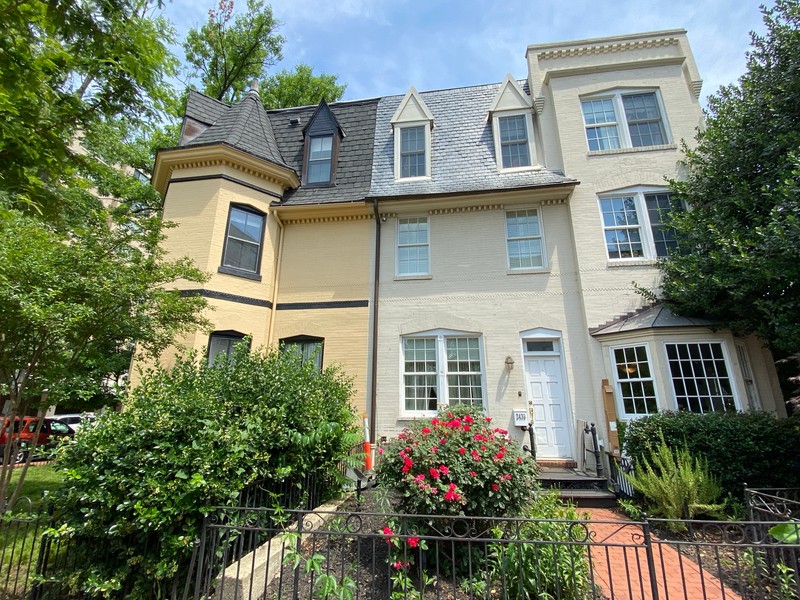
Foggy Bottom, sites south of Historic District, 1939
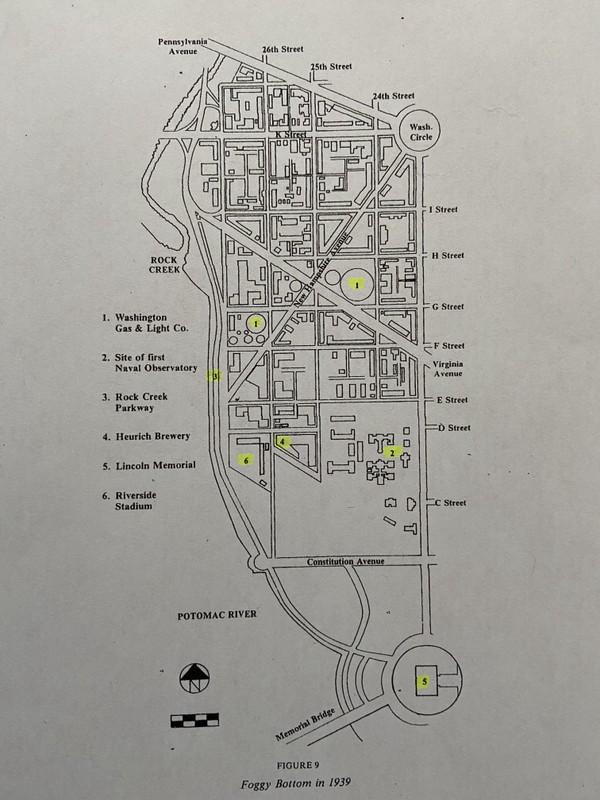
Backstory and Context
Text-to-speech Audio
With several tours to pick from, we're thrilled you want to explore Foggy Bottom. Soon after the tour starts, you'll find you've blocked out the noises of the city and are taken in by this diminutive enclave of row houses, alley houses, and urban legends.
The modest brick houses, gardens and tree-lined streets impress visitors to the community. But its ever-present history makes it unique, even in Washington. Native Americans occupied the area at least 1,500 years ago. In the 1600s, the area contained plantations and was part of the State of Maryland. Jacob Funk, a Pennsylvanian of Swiss-German ancestry, sought to build a new town (Hamburgh or Funkstown) in 1763, but that little-occupied development was incorporated into the new federal city of Washington in 1791.
After the Civil War, many skilled and unskilled immigrant laborers were attracted to Foggy Bottom by industries including breweries, lime kilns, cement plants, and the Washington Gas works. Although smog and odor from these industries made “Foggy Bottom” a less desirable place to live, those conditions also made homes affordable for workers at these plants. Moreover, the builders were often immigrants who built houses for their neighbors. These working-class houses distinguish the Historic District.
Much of historic Foggy Bottom has been lost over the years. In the 1950s, governmental, international, and commercial facilities replaced the industries. The 1960s saw construction of new apartment, cooperative, and condominium buildings. The George Washington University, which moved into the neighborhood in 1912, has expanded from a few buildings to 43 acres. The Potomac Freeway (I-66), part of a planned but never built inner-loop beltway, wiped out most of the neighborhood west of 26th Street leaving only three row houses by the entrance to the interstate. These developments destroyed many of the small narrow row houses and the working class community that had characterized Foggy Bottom since the late 1800s.
Preservation efforts began in the 1950s with the renovation of some row houses. Facing increasing development threats, the community advocated for protection of the historic buildings. In June of 1987, the D.C. Historic Preservation Office established the Foggy Bottom Historic District as a D.C. (Historic) Landmark, listed on the National Register of Historic Places.
The Foggy Bottom Historic District is generally bounded by 24th and 26th Streets, and New Hampshire Avenue and K Streets. It covers approximately three acres and four squares and contains approximately 226 buildings, of which 135 structures contribute to the Historic District. The historic buildings are mostly narrow (some less than 12 feet wide) brick two- or three-story “late Victorian” residential row houses built from the late 1870s through the 1910s. Through much of Foggy Bottom's history, local businesses also operated out of the row houses, including saloons and beauty parlors. At times it seemed like every corner had a grocery store.
From an architectural perspective, the row houses generally have flat-fronts and simple ornamentation, although there are examples of pressed and molded brick detailing builders used to make even modest houses appear distinct. Initially the houses were built for their owners, but increasingly through the 1880s groups of two or three (or more) houses were developed for sale. At least seven remaining houses in the Historic District were built in the 1880s by Irish immigrant Peter McCartney. He began as a carpenter and soon established a successful contracting business. His skill with brick and wood is found throughout the historic district including the corbelled brick cornices and delicate jigsaw work on the houses at 25th and I Streets.
The Historic District also includes nearly 30 two-story row houses built in the Snows Court and Hughes Mews alleys. Snows Court also contains a large warehouse originally constructed by Wilber Nash as a commercial horse and carriage stable in 1914 (with windows for horses on the second floor).
Sources
DC Historic Preservation Office, "Foggy Bottom Historic District Brochure" (2003) (see link below)
DC Government, Office of Planning, Foggy Bottom Historic District Nomination and related documents (1987) (see link below)
Sherwood, Suzanne Berry, “Foggy Bottom 1800-1975: A Study in the Uses of an Urban Neighborhood,” GW Washington Studies, No. 7, Center for Washington Area Studies, The George Washington University, 1974.
D.C. Historic Preservation Office
Leone/Vogt, 2021
Vogt/Leone, 2021
Leone/Vogt, 2021
Leone/Vogt, 2021
Leone/Vogt, 2021
GWU Gelman Library Special Collections
Leone/Vogt, 2021
Vogt/Leone, 2021
Sherwood, “Foggy Bottom 1800-1975: A Study in the Uses of an Urban Neighborhood"
